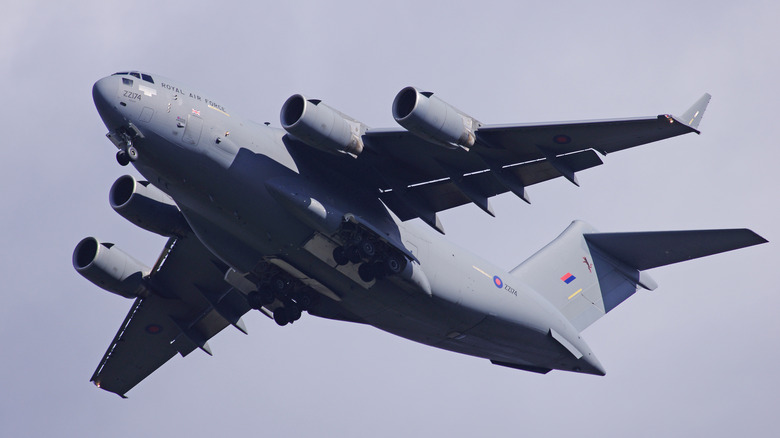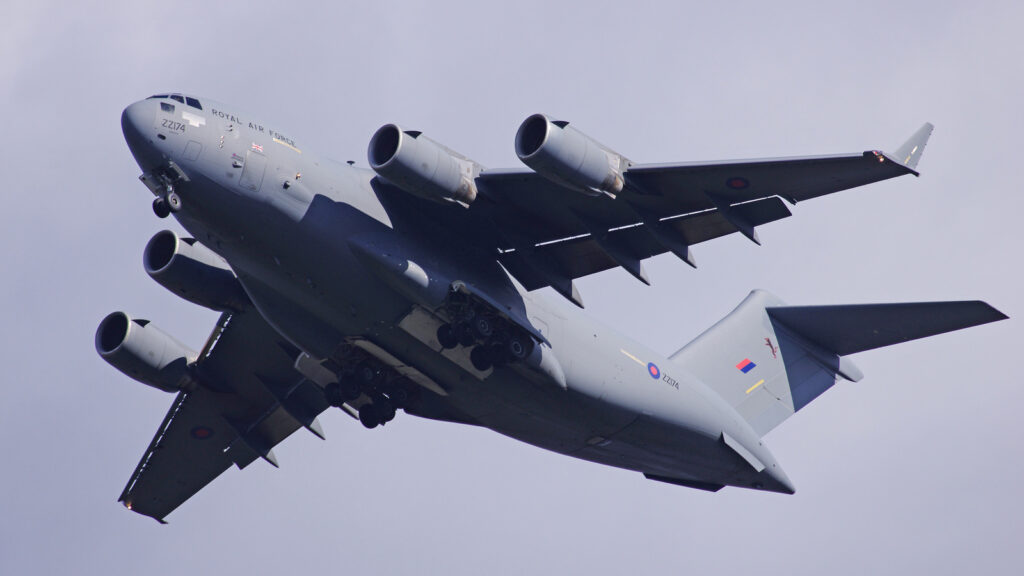
Gary Chalker/Getty Images
Big airplanes need big engines, and the C-17 Globemaster III is one of the larger aircraft deployed by the U.S. Air Force. While vehicles like the Boeing CH-47 Chinook are often used to get quickly into and out of combat areas, the C-17 Globemaster III combines the size and long-distance capabilities of traditional transport planes with increased speed and mobility for a more flexible solution to modern combat, peacekeeping, or humanitarian missions across the world. These unique and balanced demands, as well as the ability to stay properly maintained in high-stakes situations, make the engines that power the C-17 especially important to the U.S. Air Force.
Fortunately, the engineers at Pratt & Whitney — who manufacture these engines of the C-17 Globemaster III — know what they’re doing. In fact, the F117-PW-100 turbofan engines that propel the C-17 are part of the company’s century-long tradition of advancing aircraft technology and supporting the vitally important airborne capabilities of the U.S. military.
Pratt & Whitney changed air travel forever with an engine still used today
Pratt & Whitney is no stranger to the field of aviation propulsion, as the company has been building aircraft engines since the 1920s. Early in its history, Pratt & Whitney changed air travel forever with its development of the original Wasp engine. Today, the company boasts that it’s built over 85,000 engines currently in service across the globe, including the GTF used in passenger jets like the Airbus A220 and the incredibly powerful F135 that is used in the most advanced fighter jet in the world — the F-35 Lightning II.
The Pratt & Whitney Aircraft Company was founded in 1925 by Frederick B. Rentschler, who radically increased the power-to-weight ratio of aircraft engines with his air-cooled radial design. After single-handedly transforming military and commercial aviation with the R-1340 Wasp engine — which is still used today — the company moved on to gas turbine and jet propulsion toward the end of World War II, constructing a wind tunnel and engineering laboratory to advance the technology.
With dozens of factories and facilities around the world — including locations on six of the seven continents — the manufacturer and its parent company, RTX, continue to evolve as they work on more sustainable aviation in response to the threat of climate change that looms over the entire industry and beyond. This includes a commitment to net-zero air transport CO2 emissions by 2050 and the development of ultra-efficient turboprops and smarter clean, 100% sustainable aviation fuel.
Pratt & Whitney’s F117-PW-100 generates tons of thrust — and the C-17 uses four of them
Built to carry lots of personnel, equipment, and vehicles, the C-17 Globemaster III can be described as anything but small. First deployed in 1993, the transport plane is 174 feet long and over 55 feet tall, with a wingspan of nearly 170 feet. Its maximum takeoff weight is a whopping 585,000 pounds — well over 290 tons — which is why it needs multiple powerful engines to get it in, and keep it in, the air. The C-17 Globemaster III is powered by four Pratt & Whitney F117-PW-100 turbofan engines, which each produce 40,440 pounds of thrust.
Based on the PW2040 engine used by the Boeing 757, the F117-PW-100 is customized for military use and delivers higher operational performance, lower fuel burn, and improved maintenance diagnostics, in addition to meeting all current and anticipated commercial engine requirements for low noise and exhaust emissions.
With four F117 turbofan engines giving the C-17 its thrust, the cargo plane can reach speeds of 450 knots at 28,000 feet and has a service ceiling of 45,000 feet at cruising speed. The aircraft has an unrefueled range of approximately 2,400 nautical miles, but with in-flight refueling capabilities it has practically unlimited range, making it a perfect transport option for the military.
While it can carry 102 troops, 36 litter and 54 ambulatory patients and attendants, and 170,900 pounds of cargo, it only needs a crew of three — two pilots and one loadmaster — to operate. Considering the Globemaster III can take off and land on runways as short as 3,500 feet and just 90 feet wide, it’s no wonder the Air Force relies so heavily on the C-17 and the powerful Pratt & Whitney engines that fly it.
>>> Read full article>>>
Copyright for syndicated content belongs to the linked Source : SlashGear – https://www.slashgear.com/1633267/who-makes-c17-engines-globemaster-boeing-how-much-power-thrust-produce/
